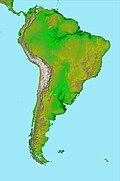Huincul Fault
[2] In the Neuquén Basin, the fault exhibits a slightly curved path, being convex to the north.[4] The main stress vector (i.e. direction of compression) was originally northwest-oriented but shifted over time to the north-northwest.In the Late Miocene, the last phase of deformation began with east–west compression followed by tectonic extension in Pliocene times.[4][5] The basement high is one of the most studied features of the Neuquén Basin, given its importance for hydrocarbon exploration and production.In this region, a series of basement highs and small pull-apart basins has formed along the fault, reflecting a clockwise movement.

Huincul FormationVaca Muerta Formationhydrocarbon maturityvitrinite reflectanceSpanishNeuquén BasinArgentine ShelfChilean Coast RangePampean orogensuture zonePatagonian terranesGondwanaToarcian ageValanginian ageAlbianStrike-slip movementstress vectorLate Miocenetectonic extensionPliocenesubductionFarallonplatesSouth Americastructurebasement highhydrocarbon explorationtranspressive fault zoneinvertedhalf-grabensRío Negrobasement highspull-apart basinsclockwise movementRevista de la Asociación Geológica ArgentinaRamos, Víctor A.Tectonic platesAntarcticCaribbeanMalpeloNorth AndesScotiaSouth AmericanCratonsshieldsAmazonian CratonArequipa-Antofalla CratonAtlantic ShieldCentral Brazilian ShieldGuiana ShieldParanapanema BlockRío Apa CratonRío de la Plata CratonSão Francisco CratonUruguayan ShieldAntarctic plateCarnegie RidgeChile RiseJuan Fernández RidgeMalpelo RidgeNazca plateNazca RidgeFaultsshear zonesAtacamaBoconóBucaramanga-Santa MartaCochabambaCordillera BlancaCórdobaDolores-GuayaquilDomeykoEastern FrontalGastreLiquiñe-OfquiMagallanes-FagnanoMorónOca-AncónPernambucoEl PilarRomeralSan RamónSarandí del YíSierra BallenaSobralEl TigreTrans-BraziliangrabensAmazon RiftAsunción RiftCuyo RiftNeuquén RiftsSalta RiftsSedimentary basinsAltiplanoAmazonAndean forelandColoradoEastern VenezuelaGolfo San JorgeMagallanesMalvinasNeuquénParanáAndeanBrasilianoCariri VelhosChonideFamatinianGondwanidePampeanSan RafaelSunsásTerra AustralisBolivian Tin BeltChilean Iron BeltDeseado MassifEl Indio Gold BeltEl MutúnIron QuadrangleLithium TriangleVolcanismVolcanic provincesCentralCentral AtlanticParaná and Etendeka